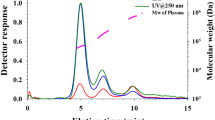Abstract
Hollow-fiber-flow field-flow fractionation (HF5) separates protein molecules on the basis of the difference in the diffusion coefficient, and can evaluate the aggregation ratio of proteins. However, HF5 is still a minor technique because information on the separation conditions is limited. We examined in detail the effect of different settings, including the main-flow rate, the cross-flow rate, the focus point, the injection amount, and the ionic strength of the mobile phase, on fractographic characteristics. On the basis of the results, we proposed optimized conditions of the HF5 method for quantification of monoclonal antibody in sample solutions. The HF5 method was qualified regarding the precision, accuracy, linearity of the main peak, and quantitation limit. In addition, the HF5 method was applied to non-heated Mab A and heat-induced-antibody-aggregate-containing samples to evaluate the aggregation ratio and the distribution extent. The separation performance was comparable with or better than that of conventional methods including analytical ultracentrifugation–sedimentation velocity and asymmetric-flow field-flow fractionation.




Similar content being viewed by others
References
Reichert JM (2008) Curr Pharm Biotechnol 9:423–430
Cromwell ME, Hilario E, Jacobson F (2006) AAPS J 8:E572–E579
Wang W (1999) Int J Pharm 185:129–188
Filipe V, Hawe A, Carpenter JF, Jiskoot W (2013) Trends Anal Chem 49:118–125
Eon-Duval A, Broly H, Gleixner R (2012) Biotechnol Prog 28:608–622
Rosenberg AS, Worobec A (2004) Biopharm Int 17:22–26
Rosenberg AS (2006) AAPS J 8:E501–E507
Carpenter JF, Randolph TW, Jiskoot W, Crommelin DJA, Middaugh CR, Winter G, Fan YX, Kirshner S, Verthelyi D, Kozlowski S, Clouse KA, Swann PG, Rosenberg AS, Cherney B (2009) J Pharm Sci 98:1202–1205
Singh SK, Afonina N, Awwad M, Bechtold-Peters K, Blue JT, Chou D, Cromwell M, Krause HJ, Mahler HC, Meyer BK, Narhi L, Nesta DP, Spitznagel T (2010) J Pharm Sci 99:3302–3321
Schuck P (2000) Biophys J 78:1606–1619
Lebowitz J, Lewis MS, Schuck P (2002) Protein Sci 11:2067–2079
Liu J, Andya JD, Shire SJ (2006) AAPS J 8:E580–E589
Arakawa T, Philo JS, Ejima D, Tsumoto K, Arisaka F (2007) Bioprocess Int 5:36–47
Arakawa T, Philo JS, Ejima D, Sato H, Tsumoto K (2007) Bioprocess Int 4:52–70
U S Department of Health and Human Services Food and Drug Administration, Center for Drug Evaluation and Research (CDER), Center for Biologics Evaluation and Research (CBER) (2013) Guidance for Industry Immunogenicity Assessment for therapeutic protein products
Arakawa T, Philo JS, Ejima, Tsumoto K, Arisaka F (2006) Bioprocess Int 4:42–43
Gabrielson JP, Brader ML, Pekar AH, Mathis KB, Winter G, Carpenter JF, Randolph TW (2007) J Pharm Sci 96:268–279
Arakawa T, Ejima D, Li T, Philo JS (2009) J Pharm Sci 99:1674–1692
Carpenter JF, Randolph TW, Jiskoot W, Crommelin DJ, Middaugh CR, Winter (2010) J Pharm Sci 99:2200–2208
Schuck P http://www.analyticalultracentrifugation.com/default.htm
Cao S, Pollastrini J, Jiang Y (2009) Curr Pharm Biotechnol 10:382–390
Jönsson JÅ, Carlshaf A (1989) Anal Chem 61:11–18
Carlshaf A, Jönsson JÅ (1989) J Chromatogr A 461:89–93
Carlshaf A, Jönsson JÅ (1991) J Mirocolumn Sep 3:411–416
Carlshaf A, Jönsson JÅ (1993) Sep Sci Technol 28:1031–1042
Reschiglian P, Roda B, Zattoni A, Tanase M, Marassi V, Serani S (2014) Anal Bioanal Chem 406:1619–1627
Kang D, Moon MH (2005) Anal Chem 77:4207–4212
Henriksson G, Englund AK, Johansson G, Lundahl P (1995) Electrophoresis 16:1377–1380
Author information
Authors and Affiliations
Corresponding authors
Electronic supplementary material
Below is the link to the electronic supplementary material.
ESM 1
(PDF 51.5 kb)
Rights and permissions
About this article
Cite this article
Fukuda, J., Iwura, T., Yanagihara, S. et al. Separation and quantification of monoclonal-antibody aggregates by hollow-fiber-flow field-flow fractionation. Anal Bioanal Chem 406, 6257–6264 (2014). https://doi.org/10.1007/s00216-014-8065-4
Received:
Revised:
Accepted:
Published:
Issue Date:
DOI: https://doi.org/10.1007/s00216-014-8065-4




